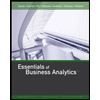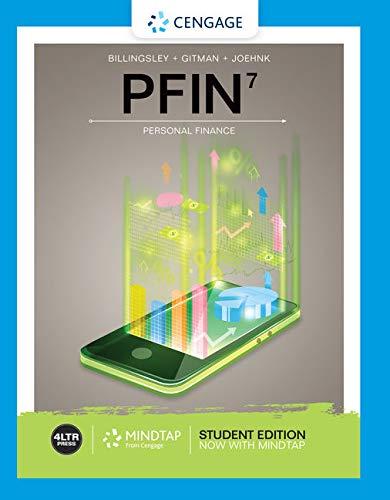
Case summary:
Person B has completed his graduation six years before, with an undergraduate degree in finance. His aim is to become an investment banker; however, he is satisfied with his present job. Person B was searching for the best college to do an MBA program, which he thinks would assist him in achieving his aim. He was looking for University W and College M. The details of Person B's current job and his course structure are provided.
Characters in the case:
- Person B
- University W
- College M
- Company DL
- College R
- College M
- School B
Adequate information:
- Person B is not allowed to work anywhere until the completion of the MBA program.
- The salaries are not paid for the internship course.
To calculate: The best option for Person B assumes that the increase in salary payment occurs at the end of every year.
Answer to Problem 3MC
Solution:
As the computed total value for each option is greater in the second option, the best option for Person B is to pursue an MBA at University W.
Explanation of Solution
Given information:
Person B currently works at a money management Company DL, whose salary is $65,000 for a year and is expected to rise to 3% in a year, until retirement. He is 28 years old and expects to be in employment for 40 more years. The average rate of tax payable by Person B is 26%.
College R at University W is one of the best programs for an MBA. It is a two-year full-time course. The fee is $70,000 annually and the cost of the book and other supplies is $3,000 for a year. After graduation, he will be employed for $110,000 with a bonus of $20,000. The salary will increase by 4% in a year and the rate of tax will rise by 31%.
School B at College M is less familiar than College R. It provides an accelerated program for one year with an annual fee of $85,000. The cost of books and other supplies for the program is expected to be $4,500. Person B would get an offer of $92,000 for a year after graduation, with a bonus of $18,000. The salary would rise to 3.5% for a year and the average rate of tax will be 29%.
Both the schools provide health insurance plans for the cost of $3,000 for a year, which must be paid at the beginning of the year. The board and room expenses will be $2,000 more for a year in both the schools. The rate of discount is 6.3%.
Note: Here, Person B has three choices; one is to remain in the same job, or to pursue an MBA at University W or at College M. As the board and room costs are not relevant, they will be the same even if Person B stays in his present job or attends the college. Compute the after-tax value under each choice.
If Person B chooses to remain at the present job, then his present after-tax value will be the following:
Formula to calculate after-tax value:
Compute the after-tax salary:
Hence, the after-tax value is $48,100.
Formula to calculate the
Note: g denotes the growing rate of annuity,
r denotes the rate of discount,
t denotes the number of years.
Compute the present value for a growing annuity:
Hence, the present value is $1,044,728.37.
If Person B chooses to pursue an MBA at University W, then his total value will be the following:
Formula to calculate the total direct costs:
Compute the total direct costs:
Hence, the total direct cost is $78,000.
Formula of present value of direct costs:
Compute the present value of direct costs:
Hence, the present value of the direct costs is $151,377.23.
Formula to calculate the present value of after-tax bonus:
Compute the present value of after-tax bonus:
Hence, the present value of the after-tax bonus of Person B is $12,212.72.
Formula to calculate the after-tax value:
Compute the after-tax value:
Hence, the after-tax value if Person B pursues MBA at University W is $75,900.
Note: As Person B’s salary will increase by 4% a year, compute the present value of after-tax of the increasing salary. Remember that Person B is expected to work for 38 more years.
Formula to calculate the present value for a growing annuity:
Note: g denotes the growing rate of annuity,
r denotes the rate of discount,
t denotes the number of years.
Compute the present value for a growing annuity:
Hence, the present value is $1,862,801.41.
As the initial payment of salary will be obtained three years from the present, discount the number of years to 2 to compute the present value.
Formula to calculate the present value for 2 years:
Compute the present value for 2 years:
Hence, the present value for 2 years is $1,648,542.05.
Formula to calculate the total value:
Compute the total value:
Hence, the total value, if Person B pursues an MBA in the University W is $1,509,377.54.
If Person B chooses to pursue an MBA at College M, then his total value will be the following:
Formula to calculate the total direct costs:
Compute the total direct costs:
Hence, the total direct costs are $94,500.
Note: This is also the present value costs, as they all are paid at present.
Formula to calculate the present value of the after-tax bonus:
Compute the present value of the after-tax bonus:
Hence, the present value of the after-tax bonus of Person B is $12,022.58.
Formula to calculate the after-tax value:
Compute the after-tax value:
Hence, the after-tax value if Person B pursues an MBA at the College M is $65,320.
Note: As Person B’s salary will increase at a rate of 3.5% in a year, compute the present value of after-tax of the increasing salary. Remember that Person B is expected to work for 39 more years.
Formula to calculate the present value for a growing annuity:
Note: g denotes the growing rate of annuity,
r denotes the rate of discount,
t denotes the number of years.
Compute the present value for a growing annuity:
Hence, the present value is $1,509,165.86.
As the initial payment of salary will be obtained two years from the present year, discount the number of years to 1 to compute the present value.
Formula to calculate the present value for 1 year:
Compute the present value for 1 year:
Hence, the present value for 1 year is $1,419,723.29.
Formula to calculate the total value:
Compute the total value:
Hence, the total value, if Person B pursues an MBA in College M is $1,337,245.87.
Want to see more full solutions like this?
Chapter 4 Solutions
UPENN: LOOSE LEAF CORP.FIN W/CONNECT
- An accounts payable period decrease would increase the length of a firm's cash cycle. Consider each in isolation. Question 6 options: True Falsearrow_forwardWhich of the following is the best definition of cash budget? Question 10 options: Costs that rise with increases in the level of investment in current assets. A forecast of cash receipts and disbursements for the next planning period. A secured short-term loan that involves either the assignment or factoring of the receivable. The time between sale of inventory and collection of the receivable. The time between receipt of inventory and payment for it.arrow_forwardShort-term financial decisions are typically defined to include cash inflows and outflows that occur within __ year(s) or less. Question 9 options: Four Two Three Five Onearrow_forward
- A national firm has sales of $575,000 and cost of goods sold of $368,000. At the beginning of the year, the inventory was $42,000. At the end of the year, the inventory balance was $45,000. What is the inventory turnover rate? Question 8 options: 8.46 times 13.22 times 43.14 times 12.78 times 28.56 timesarrow_forwardThe formula (Cash cycle + accounts payable period) correctly defines the operating cycle. Question 7 options: False Truearrow_forwardAn accounts payable period decrease would increase the length of a firm's cash cycle. Consider each in isolation. Question 6 options: True Falsearrow_forward
- Which of the following issues is/are NOT considered a part of short-term finance? Question 5 options: The amount of credit that should be extended to customers The firm determining whether to issue commercial paper or obtain a bank loan The amount of the firms current income that should be paid out as dividends The amount the firm should borrow short-term A reasonable level of cash for the firm to maintainarrow_forwardLiberal credit terms for customers is associated with a restrictive short-term financial policy. Question 3 options: True Falsearrow_forwardAn increase in fixed assets is a source of cash. Question 2 options: True Falsearrow_forward
- If the initial current ratio for a firm is greater than one, then using cash to purchase marketable securities will decrease net working capital. True or falsearrow_forwardwhat is going to be the value of American put option that expires in one year modeled with a binomial tree of 3 months step with year to expiry? assume the underlying is oil future with RF of 5% and vol of oil is 30%. Strike is 70 and price is 60 of oil. 13.68 13.44 13.01arrow_forwardhello tutor need step by step approach.arrow_forward
 Essentials of Business Analytics (MindTap Course ...StatisticsISBN:9781305627734Author:Jeffrey D. Camm, James J. Cochran, Michael J. Fry, Jeffrey W. Ohlmann, David R. AndersonPublisher:Cengage Learning
Essentials of Business Analytics (MindTap Course ...StatisticsISBN:9781305627734Author:Jeffrey D. Camm, James J. Cochran, Michael J. Fry, Jeffrey W. Ohlmann, David R. AndersonPublisher:Cengage Learning Intermediate Financial Management (MindTap Course...FinanceISBN:9781337395083Author:Eugene F. Brigham, Phillip R. DavesPublisher:Cengage Learning
Intermediate Financial Management (MindTap Course...FinanceISBN:9781337395083Author:Eugene F. Brigham, Phillip R. DavesPublisher:Cengage Learning Cornerstones of Cost Management (Cornerstones Ser...AccountingISBN:9781305970663Author:Don R. Hansen, Maryanne M. MowenPublisher:Cengage Learning
Cornerstones of Cost Management (Cornerstones Ser...AccountingISBN:9781305970663Author:Don R. Hansen, Maryanne M. MowenPublisher:Cengage Learning Pfin (with Mindtap, 1 Term Printed Access Card) (...FinanceISBN:9780357033609Author:Randall Billingsley, Lawrence J. Gitman, Michael D. JoehnkPublisher:Cengage Learning
Pfin (with Mindtap, 1 Term Printed Access Card) (...FinanceISBN:9780357033609Author:Randall Billingsley, Lawrence J. Gitman, Michael D. JoehnkPublisher:Cengage Learning





